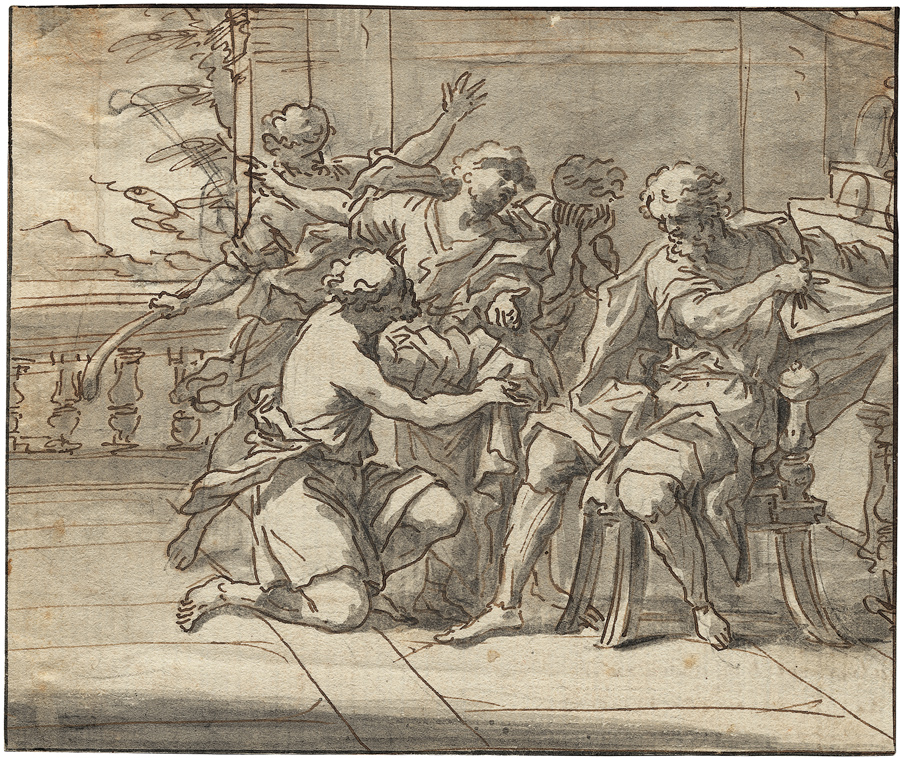Loading the page ...
Daniel Seiter
(1647 Vienna – 1705 Turin)
Jacob Gives Joseph a Coat of Many Colours. Pen and brown ink, gray wash over a subtle preliminary drawing in black chalk. 14.2 x 16.9 cm. Verso titled with pen and brown ink and inscribed: Cavalier Daniel Saiter.
Daniel Seiter is one of the most important foreign artists of the Late Baroque period in Italy. He represents a type of artist who, at the close of the 17th century, demonstrated remarkable virtuosity in bringing together in his person the multifarious achievements of preceding generations of Italian painters. Initially trained in Vienna as an officer and fortifications engineer, his eventful life took him to Venice round about the year 1667, where he took up painting in the studio of Johann Carl Loth. After a short stay in Florence he moved to Rome about 1680, where he swiftly achieved success and esteem for his altar and historical paintings in the circle around Carlo Maratta. Admitted to the Accademia di San Luca in 1686, he was appointed court painter in Turin by Victor Amadeus II of Savoy in 1688. His magnificent paintings for the Galleria di Daniele in the Palazzo Reale consisting of a synthesis of Classicist and Baroque elements were a superb testimony to the Duke’s ambitious plans (fig. 1).
Our drawing is one of a larger group of what are known as the artist’s "sketched pictures". This term refers to small-format, self-contained drawings which combine an apparently spontaneous, deliberately sketch-like style with a finished composition (see Matthias Kunze, Daniel Seiter 1647–1705. Die Zeichnungen, Salzburger Barockmuseum, Salzburg 1997, p. 46f.). Trained in the art of drawing as practised by Johann Carl Loth, Seiter continued to develop his skill in this field in Rome. He evidently met with sufficient success among patrons and collectors to transform his actual preliminary drawings for paintings into the aforementioned "sketched pictures", thus enabling him to serve his own market. This is the explanation of why his drawn œuvre contains several similar versions of the same compositions.
Seiter’s drawing style is characterized by vigorous penwork combined with a lively chiaroscuro. In keeping with the Venetian tradition he often combines white lead heightening with blue paper. Here he achieves the same effect by applying very skilfully different washes on white paper.
In iconographical terms, the drawing takes up a theme rarely dealt with in the visual arts – chapter 37 of the Book of Genesis, which relates how Jacob manifests his love for his youngest son Joseph by giving him a coat of many colours, thus arousing the anger and hostility of Joseph’s elder brothers. Seiter concentrates the action on a compact group of figures, animated in the Baroque manner, in which the kneeling Joseph and his father seated in state before him are surrounded by the agitated and angry brothers. This gives rise to a dramatic interplay of gestures and movements, which is intensified by the absence of any detailed rendering of the entourage. Both composition and style indicate that the work is probably attributable to Seiter’s post-1685 period, as is clear from a comparison with similar drawings in the public collections of Basle, Düsseldorf, Hamburg, Munich and the Louvre, Paris (see Kunze, op. cit., nos. 7, 20, 28, 32, 36).
